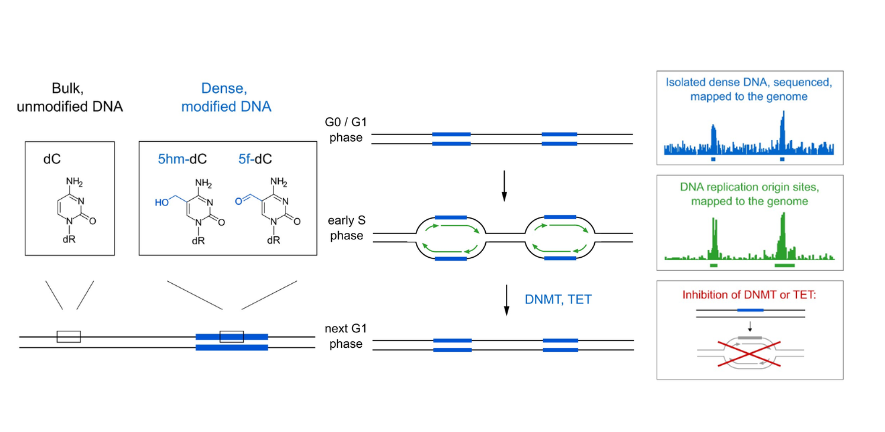
Submitted by Abigail Youngman on Fri, 09/05/2025 - 16:18
Scientists have long searched for a clear "start here" signal for DNA replication in the human genome. Research published this week in the journal Nucleic Acids Research by Dr Torsten Krude and students here in the Department of Zoology, in collaboration with colleagues at The Francis Crick Institute, reports important discoveries about the mechanism by which those start sites of DNA replication are specified in human cells.
Using density equilibrium centrifugation and DNA sequencing they identified short discrete sites in the human genome with increased density during quiescence and G1 phase of the cell cycle, which overlap with the sites where DNA replication begins in the subsequent synthesis (S) phase of the cell cycle.
The increased density is attributed to the oxidation of 5-methyl-deoxycytidine, a modified DNA base, by enzymes known as ten-eleven translocation (TET) dioxygenases. This oxidation occurs predominantly in GC-rich domains of the genome. When the researchers inhibited this oxidation process, they observed a decrease in dense DNA and a reversible halt in DNA replication and cell proliferation. They concluded that this dense, modified DNA provides an essential “start here” signal for human DNA replication.
This shift in the fundamental understanding of how human cells regulate the copying of their DNA has potential for advances in treating cancer.
Read the paper: Torsten Krude, Jiaming Bi, Rachel Doran, Rebecca A Jones, James C Smith, Human DNA replication initiation sites are specified epigenetically by oxidation of 5-methyl-deoxycytidine, Nucleic Acids Research, Volume 53, Issue 8, 8 May 2025, gkaf362 https://academic.oup.com/nar/article/53/8/gkaf362/8124944
Image: The image highlights the epigenetic modifications that mark human DNA replication start sites before their activation (left), how they are maintained during a DNA replication cycle (middle), and how they have been investigated (right). Reproduced from Krude et al (Nucleic Acids Research, 53, 2025, gkaf362) under an open access CC/BY/4.0 license.
